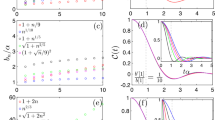Abstract
We propose a new way of investigating phase transitions in the context of information theory. We use an information-entropic measure of spatial complexity known as configurational entropy (CE) to quantify both the storage and exchange of information in a lattice simulation of a Ginzburg–Landau model with a scalar order parameter coupled to a heat bath. The CE is built from the Fourier spectrum of fluctuations around the mean-field and reaches a minimum at criticality. In particular, we investigate the behavior of CE near and at criticality, exploring the relation between information and the emergence of ordered domains. We show that as the temperature is increased from below, the CE displays three essential scaling regimes at different spatial scales: scale free, turbulent, and critical. Together, they offer an information-entropic characterization of critical behavior where the storage and fidelity of information processing is maximized at criticality.



Similar content being viewed by others
References
Shannon, C.E.: The mathematical theory of communication. Bell Syst. Techn. J. 27:379–423, 623–656 (1948)
Huffman, D.: A method for the construction of minimum-redundancy codes. Proc. IRE 40, 1098–1101 (1952)
Sethna, J.P.: Statistical Mechanics: Entropy, Order Paramenters, and Complexity. Oxford University Press, Oxford (2006)
Seeger, R.J.: On teaching thermophysics. Am. J. Phys. 26, 248–257 (1958)
Brillouin, L.: Science and Information Theory, pp. 318–328. Academic Press, New York (1956)
ibid.: Thermodynamics, statistics, and information. Am. J. Phys. 29, 318–328 (1961)
Jaynes, E.T.: Information theory and statistical mechanics. Phys. Rev. 106, 620–630 (1957)
Leff, H.S., Rex, A.F. (eds.): Maxwell’s Demon: Entropy, Information, Computing. Princeton University Press, Princeton (1990)
Parrondo, J.M.R., Horowitz, J.M., Sagawa, T.: Thermodynamics of information. Nat. Phys. 11, 131–139 (2015)
Gleiser, M., Stamatopoulos, N.: Entropic measure for localized energy configurations: kinks, bounces, and bubbles. Phys. Lett. B 713, 304–307 (2012)
Correa, R.A.C., de Souza Dutra, A., Gleiser, M.: Information-entropic measure of energy-degenerate kinks in two-field models. Phys. Lett. B 737, 388–394 (2014)
Gleiser, M., Sowinski, D.: Information-entropic stability bound for compact objects: application to Q-balls and the Chandrasekhar limit of polytropes. Phys. Lett. B 727, 272–275 (2013)
Gleiser, M., Jiang, N.: Stability bounds on compact astrophysical objects from information-entropic measure. Phys. Rev. D 92, 044046 (2015)
Gleiser, M., Stamatopoulos, N.: Information content of spontaneous symmetry breaking. Phys. Rev. D 86, 045004 (2012)
Gleiser, M., Graham, N., Stamatopoulos, N.: Generation of coherent structures after cosmic inflation. Phys. Rev. D 83, 096010 (2011)
Gleiser, M., Graham, N.: Transition to order after hilltop inflation. Phys. Rev. D 89, 083502 (2014)
Gleiser, M., Sowinski, D.: Information-entropic signature of the critical point. Phys. Lett. B 747, 125–128 (2015)
Goldenfeld, N.: Lectures on Phase Transitions and The Renormalization Group. Frontiers in Physics, vol. 85. Addison-Wesley, New York (1992)
Landau, L.: On the theory of phase transitions. Zh. Eksp. Teor. Fiz. 7, 19–32 (1937)
Hunt, J.C.R., Philips, O.M., Williams, D. (eds.): Turbulence and Stochastic Processes: Kolmogorov’s Ideas 50 Years On, vol. 434, pp. 1–240. The Royal Society, London (1991)
Langer, J.S.: An introduction to the kinetics of first-order phase transitions. In: Godrche, G. (ed.) Solids Far from Equilibrium. Cambridge University Press, Cambridge (1992)
Vilenkin, A., Shellard, E.P.S.: Cosmic Strings and Other Topological Defects. Cambridge University Press, Cambridge (1994)
Borrill, J., Gleiser, M.: Matching numerical simulations to continuum field theories: a lattice renormalization study. Nucl. Phys. B 483, 416 (1997)
Lindeberg, T.: Scale-space for discrete signals. PAMI 12(3), 234–254 (1990)
Acknowledgements
DS was supported by a Hull Fellowship at Dartmouth College. MG was supported in part by a US Department of Energy Grant DE-SC001038.
Author information
Authors and Affiliations
Corresponding author
Rights and permissions
About this article
Cite this article
Sowinski, D., Gleiser, M. Information Dynamics at a Phase Transition. J Stat Phys 167, 1221–1232 (2017). https://doi.org/10.1007/s10955-017-1762-6
Received:
Accepted:
Published:
Issue Date:
DOI: https://doi.org/10.1007/s10955-017-1762-6




